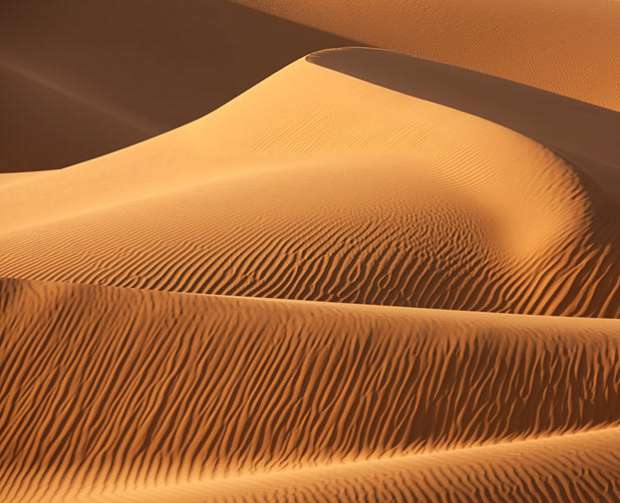The shifting, barren sands of the Great Western Erg were described as ’a land of useless and irreplaceable beauty’ by the Algerian-born writer Albert Camus, for whom this bleak, haunting landscape was home. Here, the tireless wind whips the sand into fantastic shapes which it destroys again within a matter of days. The intensity of the desert sun makes this one of the hottest driest regions on Earth, with temperatures that can soar to well above 10°F (38°C). And if the searing heat were not enough to test human endurance, the burning temperature of the sand causes a quivering of the air that blurs the edges of the landscape and confuses the eye. Moreover, the disorientating effect of a sea of identical, smooth-sided, sharply crested dunes ever-shifting towards the horizon can unnerve even the most lucid observer.
To most people, the word ‘desert’ conjures up images of miles of gently rolling, golden sand dunes (in Arabic the word ‘erg’ means ‘large area of sand’). But in fact less than a quarter of Sahara, the world’s largest desert, is made of such a landscape: 80 per cent is characterized by monotonous gravel plains, sterile rocky plateau, arid mountain peaks and mirage-inducing salt flats.
An erg’s surface layer of sand is subject to the caprices of the wind. Where strong steady winds blow from a single direction, the sand is heaped up as high as 400ft (120m) to form the familiar, great crescent-shaped dunes. In confused air patterns, where swirls and eddies means a constantly changing wind direction, the dunes are piled up into a complex assortment of shapes. In some areas they form large parallel ridges separated by broad troughs; elsewhere, converging air currents stack and sculpt the sand into huge mounds and towering pyramids.
Desert Convoy:
In spite of increasing competition from motorized vehicles, camel trains gliding across the Sahara are still a familiar sight. The Arabian camel, known as the ‘ship of the desert’, has adapted well to prevailing conditions. its broad, two-toed, thick-soled feet prevent it from sinking into the sand, and the fat stored in its hump can readily be converted to a source of water in times of drought. Bushy eyelashes and thick eyelids protect its eyes from sand and dust, and muscles in its face allows it to open and close its nostrils at will. Furthermore, the camel’s shaggy coat protects it from the harmful effects of flying sand, and an insulating layer of air within the coat prevents the animal from overheating.

This eeriest of regions is rich in local legend and folklore. Nomads tell of fearful cries piercing the night, and of scuttling figures seen trailing camel caravans in the darkness. But more frightening is the reality of the violent sandstorms that are experienced here, when winds rush across the erg with frantic fury, sweeping up huge clouds of sand in their wake. The 19th century explorer of Africa Sir Samuel White Baker describe the onset of such a storm: “I saw approaching from the south-west apparently, a solid range of immense brown mountains, high in the air. So rapid was the approach of this extraordinary phenomenon that in a few minutes we were in actual pitchy darkness… We tried to distinguish our hands placed close before our eyes, not even an outline could be seen.”
Witnesses have described walls of sand 300 miles (480km) wide travelling at speeds of 30mph (48km/h) and there are tales of entire caravans disappearing without trace during sandstorms. While the heaviest, densest sand does not rise much above ground level, finer grains and dust can be swept as high as 1 mile (1.6km), occasionally blocking out the sun in places far removed from the heart of the storm. Saharan dust can also be carried by the wind over great distances. After a particularly severe storm in Algeria in 1947, some of the snowy peaks of the Swiss Alps were tinged pink by red Saharan dust.
The sands of the great Western Erg were not borne by the wind from some far-off place, as was once thought, nor are they the residue of an ancient long dried up Saharan sea. Before the last great Ice Age loosened its grip on the northern continents some 10,000 years ago, the Sahara was a far cooler place, criss-crossed by an extensive river system. As the blanket of ice across Europe began to melt, the moist Atlantic air currents shifted away from Africa towards Europe. The rivers of the Sahara – now dominated by hot, dry winds – evaporated. With no moisture to bind the soil together, it broke down in the process losing its fertility, until gradually the rich earth became a sterile sea of shifting sand.
Crescent-shaped sand dunes, or barchans, are found in dry deserts, where strong steady winds blow from a uniform direction and where there is no vegetation to hinder their movement. The dunes have steep leeward faces, created when sand grains double back on themselves after blowing over the tops of the dunes. Because this is a constant process, the barchans can travel up to 100ft (30m) per year.

Thousands of Tuareg nomads lost their animals and livelihoods after the drought of 1972. They were forced to trek southwards to towns and villages, and their migration generated conflict in the new regions. Having lost everything and become settled in towns, the Tuareg are unlikely ever to be able to return to their former nomadic existence. Today, only a few Tuareg continue to roam the vast plains of the Sahara Desert, but they too may soon be compelled, both by the forces of nature and changes in the law, to abandon their once-proud, traditional way of life forever.



































